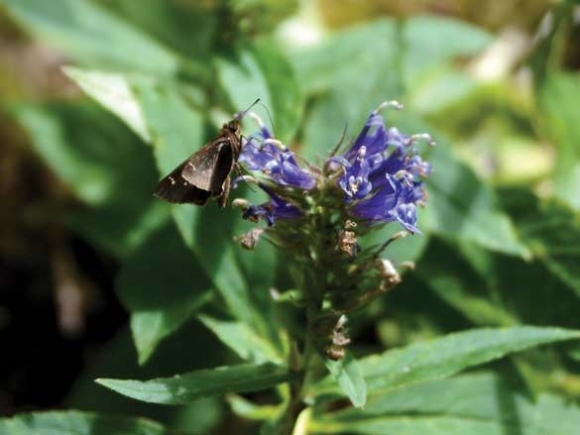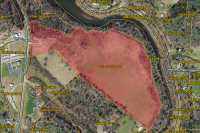Probing for pollinators: Miniature world of pollinators comes to life in Highlands

In the lull between summer’s peak and fall’s color arrival, things are on the quiet side at the Highlands Biological Station as the gardens make their transition from summer blooms to autumn vibrancy. But for those who know where to look, a world of change and color waits ripe for discovery.
That’s the world of pollinators — the army of butterflies, bees, moths, flies and wasps whose diet of nectar keeps flowers flowering.
Evidence of their work is scattered throughout the gardens, sometimes obvious in the flash of bright-colored wings flying through the air and other times more surreptitious — a tiny caterpillar hidden on the underside of an off-trail leaf, for example, or a nondescript fly darting through a field.
“Most people when they think of pollinators, they’re thinking of honeybees. They’re thinking of butterflies,” explained Jim Costa, Ph.D., director of the Highlands Biological Station and a biology professor at Western Carolina University, leading a pollinator walk around the gardens Sept. 8. “They’re not thinking about the heavy lifting that is done really by a lot of other groups.”
Flies, beetles and wasps all have important parts to play in the work of pollination.

Related Items
But butterflies were undoubtedly the focus that day, their brightly colored wings and elusive nature the subject of newfound interest for several members of the Franklin Bird Club. They’d asked Costa to show them around the gardens as they seek to sharpen their pollinator knowledge; in the future, they hope to organize more opportunities to learn about butterflies.
“We’re still at a point now where we go out and we frequently see something we’ve never seen before, so that’s really exciting,” said Renee Rubin, a member of the bird club.
She’d stopped to chat about how the birders came to develop an interest in butterflies, mentioning that one advantage that butterflies have over birds is the fact that they get up later in the day — “it’s kind of nice that you can do something and not have to get up at the crack of dawn,” she laughed — but regardless of the time the alarm goes off, she added, “we’re just so lucky here to have all this natural beauty, and butterflies are a part of it.”
“And there’s one!” she interrupted herself. “I gotta go.”
The butterfly in question was a duskywing skipper — the skippers are a type of lepidoptera (the taxonomical order that butterflies and moths share) that often get grouped in with butterflies, though they’re slightly different. The two-plus hour walk turned up many different skipper species.
Wandering past a black locust tree, Costa stopped to reveal the less obvious abode of the silver-spotted skipper’s caterpillar.
“When they’re very small, what they’ll do on an individual leaflet is they’ll cut a trench,” he explained. The caterpillar then sews down the flap with its silk, creating a cozy place to live and eat. As the caterpillar gets bigger, he told the group, it sews more and more leaves together to make its tent the proper size.
With that, Costa grabbed a stuck-together conglomeration of locust leaves and snipped it open to reveal a thick green caterpillar with bright orange eyespots, markings intended to scare away any birds that might see it as a potential meal.
The caterpillar takes every precaution to avoid such encounters. Costa said he refers to them as “poop shooters” due to the fact that they fling their frass away from the tent so an accumulation near their home won’t tip off predators to the caterpillar’s presence.
“They can shoot it meters away,” Costa said.

Other pollinators aren’t so adept. Walking along the edge of Lindenwood Lake, Costa came upon a motionless syrphid fly perched on a flower.
“It was a little suspicious that it was being so still, and it’s being so still because there’s a sly cryptic crab spider that grabbed it,” Costa explained.
Blending in so perfectly with the purple flowers that it was hard to see even when pointed out, the crab spider was lodged directly underneath the fly, clutching it tightly and draining all the nutrition from its body. Though it looked perfectly healthy at first glance, the fly was in fact dead.
There is one surefire way to avoid being caught in such traps, and that is to join the ranks of the milkweed village, a small group of insects adapted to safely eat the toxic milkweed plant. These insects often sequester the toxins in their bodies so as to keep themselves out of predators’ diets. Interestingly, Costa pointed out, “all the members of that group have converged on the same coloration pattern” — variations of red, yellow and orange sometimes interspersed with white or black.
The campus at Highlands Biological Station turns out to be a pretty good place to find pollinators. These species need flowers to thrive, and flowers don’t tend to grow well in the shaded forests that dominate much of Western North Carolina’s undeveloped areas.
“When you have dense forest, you’re not going to get a high diversity of the kinds of plants that a lot of pollinators are going for,” Costa said. “Here at the biological station what’s really nice in terms of pollinator habitat is the mosaic of habitat types.”
There are dense forest coves of rhododendron and mature trees, but there is also wetland, planted gardens, edge habitat and a meadow along Lindenwood Lake full of pollinator-friendly plants like goldenrod and Joe Pye weed.
Going forward, the biological station hopes to make its grounds even more pollinator-friendly. The Highlands Biological Foundation has raised more than $1 million in private funds to build an outdoor classroom on the lake and turn the meadow into a designated pollinator garden complete with walking paths, interpretive signs and a bee hotel.
The station will have two other big projects going on at the same time — an overhaul of its three oldest dorms funded by state repair and renovation funds and a renovation and doubling in size of its Aquatics Laboratory, funded by the National Science Foundation.
“We think that it resonates pretty deeply with what our mission is,” Costa said of the classroom and pollinator garden project. “The mission of the biological station is to really foster and support not just research and that kind of scientific understanding of the natural world, but to share that.”
Enjoy Highlands on the half-shell
A night of Cajun food and fall color will raise money for the Highlands Biological Foundation during the annual Highlands on the Half-Shell event 4:30 p.m. to dark Sunday, Oct. 1.
A feast of oysters, gumbo and other Louisiana delicacies will be served beneath flame-color leaves in the amphitheater, with participants invited to come dressed in their favorite “Cajun casual” outfit. Proceeds support the nature center, botanical garden and biological laboratory at Highlands.
$75 for members and $100 for nonmembers. Purchase tickets at www.highlandsbiological.org.
Costa’s new book
In addition to teaching at Western Carolina University and directing the Highlands Biological Station, Jim Costa is an author with a new book now on shelves — Darwin’s Backyard: How Small Experiments Led to a Big Theory.
Darwin’s Backyard presents a historically accurate version of Darwin that contrasts to the dour image many have of him based on stern Victorian-era photographs. Costa reveals Darwin as a homebody, devoted correspondent and jokester who held a lifelong curiosity about the natural world, conducting experiments that would prove historically significant in his backyard.
The book includes instructions for 18 hands-on experiments intended to let readers follow in Darwin’s footsteps and make discoveries of their own.
Darwin’s Backyard is available at the Highlands Nature Center, local bookstores, national booksellers and online distributors.









